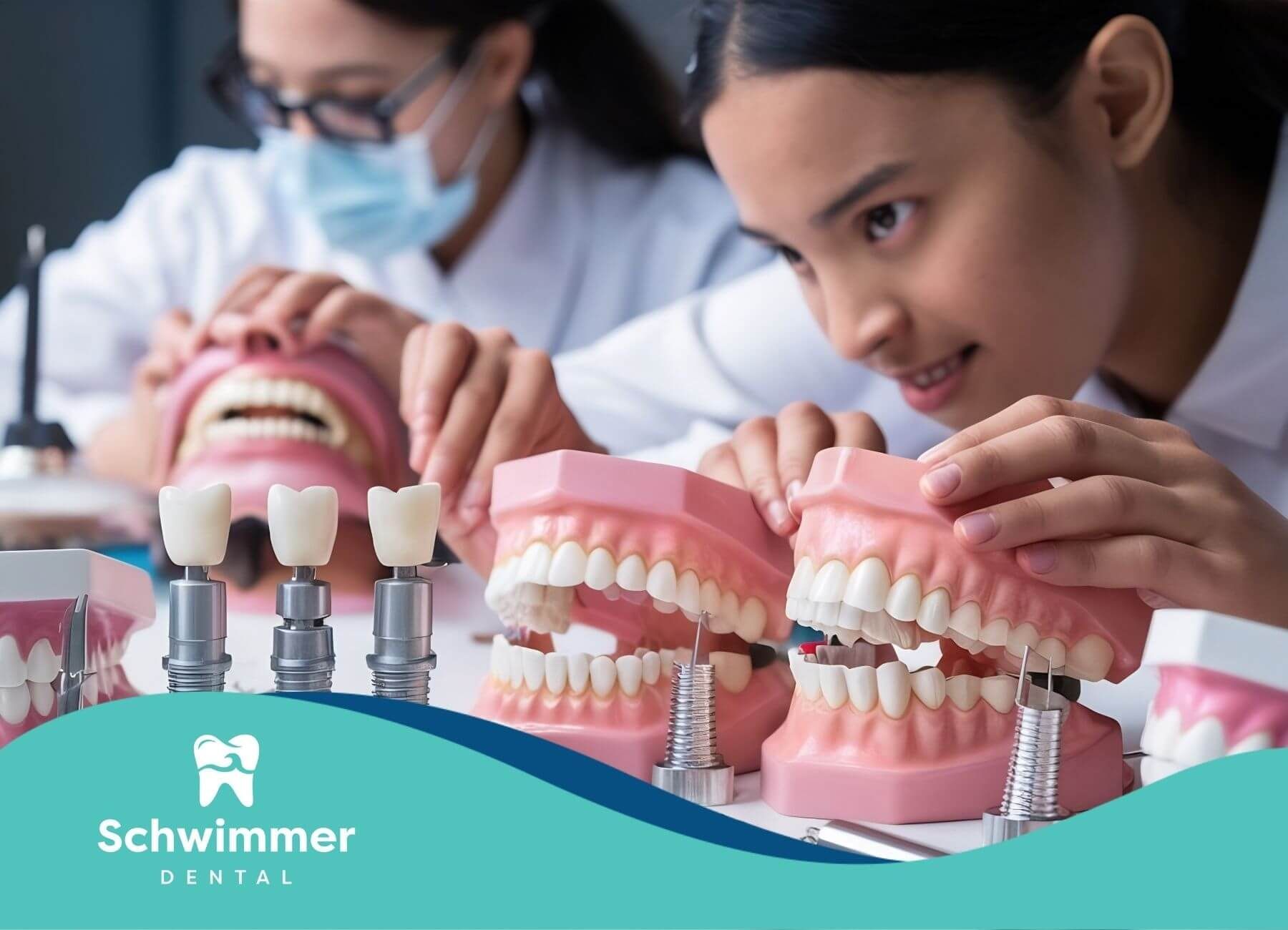What It Means to Have Crossbite in Children and How to Help
Understanding Crossbite
A comprehensive grasp of crossbite is essential for parents and dental professionals alike as it significantly affects a child's dental development and overall oral health. Crossbite is a form of malocclusion that can have lasting effects if not addressed timely.
Definition and Causes
Crossbite is a dental malocclusion characterized by an improper alignment between the upper and lower teeth where the upper teeth fit inside the lower teeth upon biting. This condition can affect various stages of dentition, including baby teeth, mixed dentition (a combination of baby and permanent teeth), and only permanent teeth.
The causes of crossbite in children range from genetic factors to environmental influences. Common causes include:
- Pacifier Overuse: Extended use of pacifiers can lead to improper alignment of the teeth.
- Bottle Use as Pacifier: Using a feeding bottle instead of a pacifier can also contribute to crossbite.
- Thumb Sucking: Prolonged thumb sucking can significantly alter the proper development of dental structures.
- Atypical Swallowing: Abnormal swallowing patterns can influence the positioning of the teeth.
- Oral Breathing: Consistently breathing through the mouth instead of the nose can affect jaw development.
- Enlarged Tonsils and Adenoids: These can cause breathing issues that impact oral posture, affecting teeth alignment.
Risk Factors
Certain factors can increase the likelihood of developing a crossbite. These risk factors can be broadly classified into genetic predispositions and environmental elements.
Genetic Risk Factors
- Family History: If parents or siblings have a history of malocclusion, the child is more likely to develop similar dental issues.
- Jaw Size and Shape: Inherited characteristics of jaw size and shape can predispose a child to crossbite.
Environmental Risk Factors
- Habits: Non-nutritive sucking habits like thumb sucking and pacifier use.
- Health Conditions: Respiratory issues due to enlarged tonsils or chronic mouth breathing.
- Delayed Loss of Baby Teeth: Retaining baby teeth longer than usual can cause crowding and misalignment.
Understanding these risk factors is crucial for early detection and prevention. Early diagnosis can lead to effective crossbite treatment options and reduce the risk of long-term complications. For more information on the differences between types of malocclusions, see our article on crossbite vs overbite.
Effects of Crossbite
Crossbite in children can lead to several complications if left untreated. Understanding these effects helps parents and caregivers recognize the importance of early intervention.
Dental Complications
Crossbite can lead to a variety of dental issues affecting teeth and gums. These complications include:
- Uneven Wear Patterns: Misaligned teeth result in uneven wear on the enamel, leading to premature tooth wear.
- Enamel Damage: The friction from misaligned teeth can wear down the enamel, increasing the risk of cavities and tooth decay.
- Increased Risk of Tooth Decay and Gum Disease: Difficult-to-clean areas due to misaligned teeth can foster plaque buildup, exacerbating the chances of cavities and gingivitis.
- Improper Force Distribution: Crossbite affects the distribution of force during biting and chewing, possibly leading to tooth fractures or sensitivity.
- Temporomandibular Joint (TMJ) Issues: Untreated crossbite can lead to problems in the TMJ, causing jaw pain, clicking or popping sounds, stiffness, and difficulty in opening or closing the mouth.
Impact on Speech
The misalignment caused by crossbite affects the normal movement of the tongue, resulting in speech difficulties. Children with crossbite may exhibit:
- Articulation Problems: Difficulty in the clear pronunciation of certain sounds.
- Lisping: The misalignment can lead to a permanent lisp, where the "s" and "z" sounds are transposed.
Facial Asymmetry
Untreated crossbite can also contribute to facial asymmetry, impacting the jawline, chin, and smile. This can lead to:
- Jaw and Chin Deformities: Misaligned teeth can distort the natural alignment of the jaw and chin.
- Smile Irregularities: Uneven teeth alignment can result in an asymmetrical smile.
- Self-Esteem Issues: Children may develop self-esteem issues due to facial asymmetry, impacting their confidence and social interactions.
Understanding these effects highlights the need for timely intervention.
Early Intervention Importance
Addressing crossbite in children at an early stage is crucial for mitigating potential complications and ensuring optimal dental health. Understanding the benefits of timely treatment and the importance of preventing long-term issues can significantly impact a child's oral well-being.
Benefits of Timely Treatment
Early intervention for crossbite in children offers several key benefits. By addressing the misalignment sooner rather than later, parents and dental professionals can guide the proper alignment of teeth and jaw, which leads to several positive outcomes:
- Correcting Misalignment: Early treatment can help align the upper and lower jaws properly, preventing further complications associated with crossbite.
- Improving Oral Function: Correcting crossbite enhances oral function, making it easier for children to chew and speak.
- Enhancing Facial Aesthetics: By preventing the development of facial asymmetries, early treatment contributes to a more balanced facial appearance.
- Reducing the Need for Extensive Procedures: Early correction can minimize the need for more invasive and costly dental treatments in the future.
Preventing Long-Term Issues
Intervening early to address crossbite can prevent a range of long-term issues that may arise if the condition is left untreated. Studies have shown that untreated crossbites can lead to muscle, skeletal, and joint adaptations, which may result in permanent growth alterations and facial asymmetries. Early diagnosis and treatment are therefore essential.
| Potential Long-Term Issues | Early Intervention Benefits |
|---|---|
| Muscle Adaptations | Prevents abnormal muscle adaptation |
| Skeletal Changes | Guides proper skeletal development |
| Joint Problems | Reduces the risk of joint complications |
| Facial Asymmetry | Enhances balanced facial growth |
Diagnosing a crossbite of skeletal origin can be done at a very early age, making it important to have an orthodontic assessment by age 6. Early intervention helps in distinguishing between dental and skeletal crossbites, enabling targeted treatment strategies.
For more information on different types of crossbite and their implications, visit types of crossbite. Additionally, parents can consider various crossbite treatment options to make informed decisions for their child's dental health.
Treatment Approaches
When it comes to addressing crossbite in children, there are several treatment approaches available. These methods aim to correct the misalignment and prevent further complications related to the dental condition.
Orthodontic Devices
Orthodontic devices are commonly used for treating crossbite in children. These devices include braces, clear aligners, and retainers. Each type offers different benefits and effectiveness depending on the severity of the crossbite and the child's dental structure.
| Orthodontic Device | Description | Advantages |
|---|---|---|
| Braces | Metal or ceramic brackets bonded to the teeth with wires passed through them | Effective for severe cases, precise control |
| Clear Aligners | Transparent, removable trays that slowly move teeth into place | Discreet, removable for eating and cleaning |
| Retainers | Devices worn post-treatment to maintain correct alignment | Maintains results, removable |
For further details on different types, you might find our related article on crossbite correction in adults informative, as many devices are also used in adult treatments.
Role of Expansion Therapy
Expansion therapy is a key treatment for crossbite, particularly for young children whose jaws are still growing. This method uses an expander device to widen the upper jaw, providing better alignment with the lower jaw. Expansion therapy is most effective when started early, ideally before the age of 12.
The typical duration for expansion therapy is about 7-8 months. The expansion process is gradual, allowing the upper jaw's soft tissue (suture) to convert into bone naturally. This method minimizes the risk of complications and leverages the child's natural growth for effective correction.
Surgical Options
In severe cases where orthodontic devices and expansion therapy are insufficient, surgical options may be considered. Surgical correction of crossbite involves adjusting the jawbone to achieve proper alignment. This is typically recommended when the child has reached an age where growth is complete, thus ensuring long-lasting results.
Surgical methods may include:
- Palatal Expansion Surgery: Widening the upper jaw in cases where non-surgical expanders are ineffective.
- Orthognathic Surgery: Realigning both jaws for severe skeletal discrepancies.
Considering surgical options is often a last resort, and comprehensive consultation with an orthodontist and oral surgeon is essential for making informed decisions.
Understanding the variety of treatment options for addressing crossbite in children can help parents and caregivers make an informed choice.
By considering the specifics of each treatment approach, parents can ensure their children receive the most appropriate and effective care for their crossbite condition.
Crossbite in Children
Crossbite is a common dental condition that can present unique challenges for children. Understanding its development, diagnosis, and the various orthodontic correction methods available can help parents and caregivers manage this condition effectively.
Development and Diagnosis
Crossbite can develop at any age in children due to the constant growth and change of dental arches. However, a crossbite with a skeletal origin can often be identified at a very early age. Scheduling an appointment with an orthodontist at age 6 is crucial for an accurate differential diagnosis.
Regular orthodontic reviews are essential to ensure timely diagnosis and treatment. Examination and treatment during childhood or early adolescence (between ages 7 and 9) are recommended to achieve the best results. This proactive approach can help prevent potential issues related to facial, dental, muscular, or joint development.
| Age Group | Orthodontic Recommendations |
|---|---|
| 6 years | Initial appointment for differential diagnosis |
| 7-9 years | Optimal age for examination and treatment |
Orthodontic Correction Methods
Several orthodontic treatment options are available for correcting crossbite in children. These methods vary based on the severity and type of crossbite.
Rapid Palatal Expander (RPE)
A rapid palatal expander (RPE) is a common device used in interceptive orthodontics. It is typically recommended for children between the ages of 6 and 12. The RPE gradually widens the palate to achieve the desired width, providing significant orthopedic effects on the bones when treatment starts at a younger age.
Orthodontic Braces
Orthodontic braces are another effective method for correcting crossbite. Braces can align teeth properly and correct bite issues. They are often used in combination with other devices like the RPE to achieve comprehensive results.
Surgical Interventions
In cases where a crossbite has a significant skeletal component and is not treated timely with orthopedic methods, surgical options might be considered. Surgery to reopen the palatal suture or utilizing dental movements to camouflage the malocclusion are potential approaches.
Ignoring crossbite treatment can lead to complications such as facial asymmetry, dental wear, and joint issues. Early and regular visits to the orthodontist can mitigate these risks.
Prevention and Management
Addressing crossbite early on can help prevent long-term complications and improve a child's oral health. Understanding the preventative measures and management practices that can mitigate the risk of developing crossbite is essential for parents and caregivers.
Genetic Influences
Genetic factors significantly influence the development of crossbite. Inherited traits, such as the size and shape of the jaws, play a crucial role in the formation of this dental condition. If a family member has a crossbite, other family members are more likely to develop the condition as well. Recognizing this genetic predisposition allows parents to be vigilant and seek early intervention if necessary.
Lifestyle Habits
Certain lifestyle habits can exacerbate the risk of developing crossbite in children. Prolonged thumb sucking, the use of pacifiers beyond infancy, and habitual tongue thrusting are notable contributors. These habits can alter the shape of the jaw and teeth alignment, leading to crossbite.
To minimize the risk, parents should:
- Encourage children to avoid thumb sucking.
- Limit the use of pacifiers after the age of two.
- Monitor and guide proper tongue positioning.
Incorporating these practices can help prevent the development of crossbite and other related dental issues.
Importance of Regular Check-ups
Regular dental check-ups play a vital role in the early detection and management of crossbite. Routine visits to the dentist allow for the timely identification of any alignment issues. Dentists and orthodontists can recommend appropriate interventions, such as orthodontic devices or expansion therapy, to correct the condition before it leads to more severe complications.
Additionally, regular check-ups ensure that any existing dental problems, such as tooth decay or gum disease, are addressed promptly. This comprehensive approach contributes to overall oral health and reduces the risk of complications associated with crossbite.
| Frequency of Check-Ups | Reason |
|---|---|
| Every 6 months | Routine dental examinations and cleanings. |
| Annually | Orthodontic evaluations for early detection of misalignment issues. |
By understanding the genetic influences, adjusting lifestyle habits, and prioritizing regular dental check-ups, caregivers can effectively manage and prevent crossbite in children. Early intervention and consistent monitoring are key to ensuring optimal oral health and preventing long-term complications.
SOURCES:
https://pmc.ncbi.nlm.nih.gov/articles/PMC8600852/
https://pmc.ncbi.nlm.nih.gov/articles/PMC9223594/
https://www.webmd.com/oral-health/what-to-know-about-crossbite
https://en.wikipedia.org/wiki/Crossbite
https://www.healthline.com/health/crossbite
https://www.colgate.com/en-us/oral-health/adult-orthodontics/crossbite-correction-how-to-straighten-your-smile
https://pmc.ncbi.nlm.nih.gov/articles/PMC5754998/



